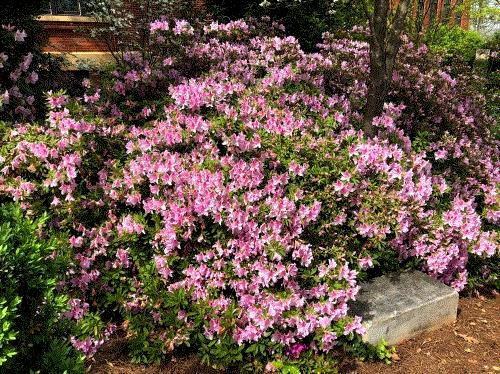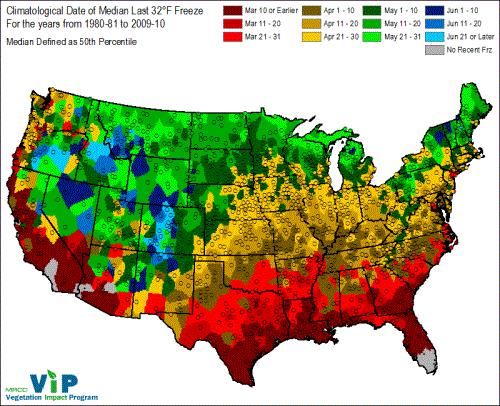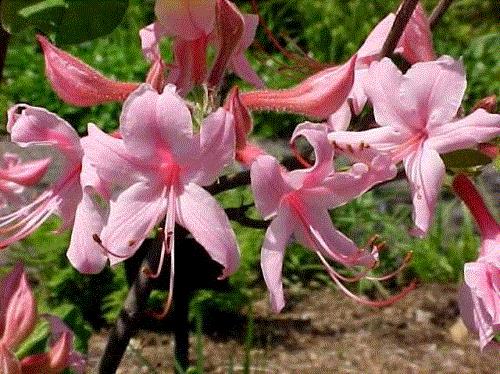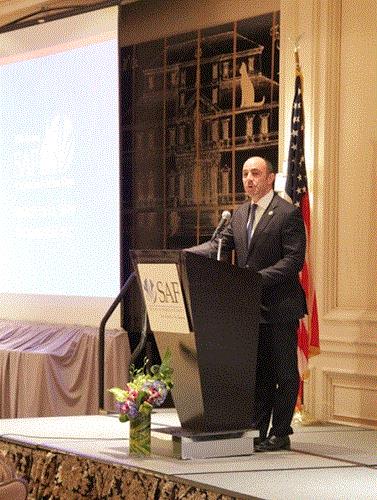An Ode to Augusta National—George Taber
Master’s week just wrapped up and I must say that the azaleas at Augusta National this year were as good as I've seen them in 10 years. Every year, glancing at those beauties, makes me think of my favorite (“non-reblooming”) azalea. That’s not to say it won’t spit some blooms in autumn, especially if the plant is stressed by summer drought.
It’s not some new patented cultivar, not some super hard-to-find elitist cultivar, not exactly suited for a container or small space or terribly sexy outside of three to four weeks in the spring. But George Taber, when it blooms, makes me want to lay down beside it and caress it’s beautiful light pink petals with cute freckles. And when it blooms, I don’t know of another cultivar that's as reliably covered in blooms year after year.

Like I said, this is a big azalea, as in an 8-ft. tall and wide behemoth at maturity. It seems to be a little more cold hardy compared to other Southern Indica types as well, which aides in its reliable spring bloom even into Zone 7a if protected from winter winds. As with all azaleas, the key to good growth is mulch and more mulch. Even in hot locations, cool roots are what makes a successful planting.

Flippin’ Cold—Go Away!
I must admit, one of my favorite spring activities is to torment anyone north of Athens, Georgia, regarding how beautiful spring in the south is (especially compared to spring at the Ball Publishing mothership in West Chicago, Illinois).
This usually begins the first week of March and concludes in late May, when the southeast becomes just plain hot (which is why we invented pools). However, this spring has been pretty chilly across North America, but especially east of the Rocky Mountains. And while not consistently cold outside of the northern tier states, the persistent cool air does seem to be affecting sales and not in a good way.

Regardless of how cool it's been, it's always good to look back to average last frost/freeze dates to really gain an understanding of when spring kicks into high gear. Image courtest of the National Oceanic and Atmospheric Administration.
I like to first tackle the why factor when it comes to weather. Why has it been so cool? Well, this year, like the past three winters, has ended with a large high pressure in the North Atlantic. This high funnels cool air down from Canada into the plains and northeastern U.S., which occasionally filters down to the Gulf Coast. The later into spring we get, with warm air surging north, we run into a scenario where decent storm systems form along the warm/cold boundary and provide snow to the north and rain to the south. From a drought standpoint, this is great. From a sales perspective, it stinks.
The good news is that medium range forecast models show the high breaking down, and when it does, then we'll likely return to more normal spring weather.

Free Pathology Webinar Wednesday
Dr. Janna Beckerman, Professor of Plant Pathology at Purdue University, will be presenting a FREE webinar this Wednesday (tomorrow!). The title of her presentation appropriately celebrates the 2018 MLB season: “Don’t Balk at Plant Diseases—Strike Them Out!”

Game time: Wednesday, April 11, 2018 at 1:00 p.m. Eastern/Noon Central.
Obviously, Dr. Beckerman is a big baseball fan, and like her favorite sport, the spring season is here and plant pathogens have come to play. Unfortunately, diseases aren't a big hit for growers and can greatly reduce a plant’s marketability or even led to crop losses. Come join one of our industries top pathologists on Wednesday as Dr. Beckerman shares the latest information on managing and controlling several plant pathogens, including Anthracnose, Botrytis, leaf spots and Pythium. With all of this great information, this exciting webinar my even go into extra innings.
Step up to the plate and click here to register for this FREE webinar.
Generously sponsored by BASF.

Northerners Need Azaleas, Too!
It’s amazing to me how many folks up north say, “We can’t grow azaleas!” Well, let me introduce you to a beauty that will do perfectly fine from Zone 4b-7a.
Rhododendron prinophyllum (roseshell azalea) is a native deciduous azalea with beautiful pink blooms in spring that's well suited for gardens from the upper Midwest to coastal New England. I’ve even seen it in the Rocky Mountains, although it’s not native to this region.

It’s a big azalea with age, coming in at about 6-ft. tall and it does better in wooded areas than full sun. Like all azaleas, mulch is key to a healthy plant. If it had one nemesis (when planted in the correct location), it would be deer. But I hear deer are allergic to lead, so there's effective deer-control strategies where allowable. The other issue with this species is heat. When possible, avoid afternoon sun at all cost.
JZ at Congressional Action Days
With Congressional Action Days in the books, I thought readers would enjoy an update from my colleague (actually my boss) at Ball Publishing, Jen Zurko. So take it away JZ (it's well worth the read)!
This is my second time attending Congressional Action Days (CAD) and the third time I’ve been in D.C. at industry lobbying events in a year and a half. The main reason I wanted to take the trip to D.C. this year was because the event included a trip to the White House for an exclusive briefing (more on that later).
Not that the Society of American Florists (SAF) doesn’t get high-caliber speakers every year, but this year was particularly good. Cornerstone Government Affairs, a consulting firm that assists SAF with its lobbying and advocacy efforts, held a point/counterpoint discussion between two of their staff: Jim Richards for the Republican side and Mike Smith for the Democrats. It was actually a relatively friendly back-and-forth on issues like immigration reform and the Deferred Action for Childhood Arrivals (DACA) program, infrastructure, the Affordable Care Act employer mandate and the polarization of politics in Washington.
That afternoon, we all got on the bus, headed to the Capitol and survived two rounds of security to get into the Eisenhower Executive wing of the White House for a briefing from six senior-level administration officials. We were updated on a wide range of topics—addiction assistance programs for employees, taxes and wages, immigration, and trade. Ray Starling, Assistant to Secretary of Agriculture Sonny Purdue (and who spoke at AmericanHort’s Impact Washington event last September) was able to make a brief appearance to talk about plans for infrastructure, which includes rebuilding roads to improve ground transportation. He also mentioned the recent tariffs the President has imposed on steel and aluminum, and the concerns many in the ag sector have of retaliation for exports from U.S. farms. Mr. Starling said that they will have to watch for these and deal with them on a case-by-case basis.
I was lucky enough to attend the SAFPAC dinner, which featured Major Garrett as speaker. Mr. Garrett is Chief White House Correspondent for CBS News and covered the Trump campaign almost from the beginning—giving him lots of fodder for his new book. He’s been in the journalism biz for over 30 years, so it was interesting to hear him admit that he still doesn’t know it all about this game called politics.
“I had built up what I thought was a pretty reliable body of knowledge,” he said. “Then 2016 happened. I am much more guarded about my certainty now.”
He advised us to “read everything you can, from both sides” and how you can tell whether it’s “real” news or propaganda. “If everything you read every day makes you feel good, you’re doing it wrong,” he said.

Congressman Jimmy Panetta (D-CA) addresses CAD attendees.
Before we headed for the Hill, Congressman Jimmy Panetta (D-CA) gave us the pep talk we needed to talk with our state legislators. The grandson of Italian immigrants and son of Leon Panetta, the freshman congressman spoke about how growing up in the hotbed of agriculture in the Salinas area of California, he was no stranger to walking through rows in the fields, whether it was flowers, vegetables or strawberries. Rep. Panetta serves on the House Agriculture Committee and the subcommittee for Biotechnology, Horticulture & Research, which is why SAF calls him “one of the floral industry’s biggest advocates in Congress.”
SAF fully prepared us for the three issues we were presenting to our policymakers: 1) Immigration policies that affect horticulture, especially concerns with stand-alone E-verify; 2) passing the funding for the Floriculture & Nursery Research Initiative (FNRI); and 3) reinstating the Floriculture Crops Report.
For any of you who thinks going to talk to your government representatives is a waste of time, I can tell you that last year we asked for $250,000 for the FNRI and they actually put through $1,000,000 in the 2018 budget—which is great!
Our timing was interesting … The congressional visits were more of a whirlwind this year because almost all of the legislators were on the floor or in meetings pitching their wants for the new appropriations bill (which has since passed). As we walked through the cold to the congressional buildings, pairs of shoes were being placed in front of the Capitol Building representing all of the victims of school shootings. And the buzz from the news of the Secretary of State’s firing was crackling through the air. If the breaking news that pops up on your phone can jolt you out of your chair, being on the Hill when it happens in real time gives you a whole new perspective.

New Ownership for Three Village Nurseries Landscape Centers
The wheels keep turning in the acquisitions department, this time in California. TreeTown USA announced at the end of March that it had sold three of the Village Nurseries Landscape Centers to SiteOne Landscape Supply, Inc. The locations affected include the Huntington Beach, Orange and Sacramento facilities. The San Diego facility was not included in the deal.
It seems that the deal will be beneficial to both companies. TreeTown USA will be able to better focus on its core mission of nursery production and SiteOne Landscape Supply, Inc. will expand its offerings beyond hard goods. Sounds like a winner to me!
iScape—An Interesting New App
iScape is a relatively new app that I was asked to promote in the newsletter a few weeks ago. The issue is I don’t promote things until I actually use them because I don’t want to promote bad products—then you readers would think I've lost my mind completely! So I downloaded it on March 23 and have been tinkering with it ever since. So far, I’m on the fence regarding this app (more on that later).
The basis of the app is simple. You take a photo of the area that needs to be landscaped and overlay a variety of template photos (ornamentals, turf, hardscape, etc.) onto the original landscape shot to design the space. Then you can save the image to the cloud (you know, that hard drive that exists somewhere in the stratosphere) and recall it later, print it, and/or share it. Okay, I get it. It took me about 60 seconds to figure that out and be off to the races.
The good points of the app are how intuitive it is, how user friendly it is and simply the fact it's a neat idea. I also like the fact that in the pro version you can upload plant images to create your own plant database (in addition to the base plant database the app comes with).
My biggest gripe is that the consumer version isn't free. I can see where the professional version would require a subscription ($19.99/month or $199.00/year), but charging $4.99/month for the consumer version is a bit much in my fiscally conservative mind. Also, while my 42-year-old eyes (with 20/10 vision) did well on my iPad’s screen, my iPhone X screen was just too small to be of any use. What I would really like is a version that runs on my iMac 27-in. screen, which isn’t available.
Overall, it comes down to if I would purchase the app. If I had a landscape contracting business, I can see where it would be beneficial to assist clients in visioning the end result of a project. For me, as a plant geek and primarily a consumer, I can’t justify the monthly subscription fee. If it were a one-time purchase fee, I would absolutely purchase it. If you’ve used it and love or hate it, let me know.

Our Wacky Wonderful World—Notes from the Edge of Sanity
If you’re like me, you groan when a college professor begins to explain the answer to a simple question and 30 minutes later, you’re still standing there, more confused than when you asked the question. That’s why I appreciate self-guided resources to assist growers and landscape contractors so much.
One group of USDA funded researchers, known as the Clean Water3 team, continues to do an outstanding job at developing the types of resources that growers can use to make complex issues simple to understand.

Their latest instrument to help growers is the WaterQual tool, which was developed to assist in interpretation of water quality for greenhouse and nursery crops. I’ve tried it out and it's absolutely marvelous! Although not specifically developed for the landscape industry, it has some functionality (particularly “total ions and alkalinity”) that would be very beneficial to contractors in areas with poor water quality.
There’s something else that I'm grateful for when it comes to this research team, as well as the tools and resources they produce. They're funded by a USDA Specialty Crops Research Initiative grant. This is a program that, since its inception, has greatly advanced our industry through better funding that leads to better practices, products and resources to improve your productivity.
You may wonder, “What can I do to advance our industry?” I propose that you make your voice heard in support of this and other federally funded grant programs when the next Farm Bill debate heats up. And that debate has already started, so sooner would be better than later.
There are a multitude of avenues to promote teams like Clean Water3, from directly contacting your representatives to driving advocacy in your state and/or national associations to supporting these teams with in-kind contributions (e.g. space to conduct their research). I hope you consider doing so because it drives (and will continue to drive) innovation in our industry.

Live authentic,

Matthew Chappell
Editor-at-Large
Nursery & Landscape Insider
This has been received by 29,835 of the hardest-working horticulturists in show business!
If you're interested in reaching 29,834 (and growing) clients who eagerly await every Nursery & Landscape Insider and surely read every word, contact Kim Brown ASAP and she'll hook you up. And spread the word... let's get to 30,000 readers!